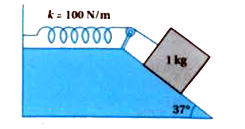Three sound waves of equal amplitude have frequencies (n-1), n, (n + 1). They superimpose to give beats. The number of beats produced per second will be ? Solution in Gujrati
3
2
1
4
The correct Answer is:B
Maximum no. of beats per unit time,
=fmax−fmin
=(n+1)−−(n−1)=2
Topper's Solved these Questions
- WAVESBOOK - KUMAR PRAKASHANCHAPTER - WAVESEXERCISE - SECTION-F (Questions From Module) (Sample questions for preparation of competitive exams)
23 Videos
- WAVESBOOK - KUMAR PRAKASHANCHAPTER - WAVESEXERCISE - SECTION-D (NCERT Exemplar Solution) (Long Answer Type Questions)
5 Videos
- UNITS AND MEASUREMENTBOOK - KUMAR PRAKASHANCHAPTER - UNITS AND MEASUREMENTEXERCISE - Section -F (Questions from Module )
20 Videos
- WORK, ENERGY AND POWER BOOK - KUMAR PRAKASHANCHAPTER - WORK, ENERGY AND POWER EXERCISE - QUESTION PAPER (SECTION - D)
1 Videos
Similar Questions
In a standing wave formed by two atoms separated by 1.21Å, there are 3 nodes and 2 antinodes. Find its wavelength.
View SolutionThe earth has a radius of 6400 km. The inner core of 1000 km radius is solid. Outside it, there is a region from 1000 km to a radius of 3500 km which is in molten state. Then again from 3500 km to 6400 km the earth is solid. Only longitudinal (P) waves can travel inside a liquid. Assume that the P wave has a speed of 8 kms−1 in solid parts and of 5kms−1 in liquid parts of the earth. An earthquake occurs at some place close to the surface of the earth. Calculate the time after which it will be recorded in a seismometer at a diametrically opposite point on the earth if wave travels along diameter ?
View SolutionIf the error in measurement of radius of a shpere is 2% then the error in determination of volume of the sphere will be …………
View SolutionA 1 kg block situated on a rough incline is connected to a spring constant 100Nm−1 as shown in figure . The block is released from rest with the spring in the unstretched position . The block moves 10 cm down the incline before coming to rest . Find the coefficient of friction between the block and the incline .Assume that the spring has a negligible mass and the pulley is frictionless.

View SolutionThree sound waves of equal amplitudes have frequencies (v - 1), v, (v + 1) . They superpose to give beats. The number of beats produced per second will be :
View Solutionसमान आयाम की तीन ध्वनि तरंगो की आवृतिया क्रमशः (n−1),n,(n+1) है। इनके अध्यारोपण से विस्पन्द उत्पन्न होते है। प्रति सेकण्ड उत्पन्न विस्पन्दो की संख्या है:
View Solutionसमान आयाम की तीन ध्वनियों की आवृतियाँ n - 1, n तथा n + 1 हैं। ये अध्यारोपित होकर विस्पन्द उत्पन्न करती हैं। प्रति सेकण्ड विस्पन्दों की संख्या होगी :
View SolutionThree sound waves of equal amplitudes have frequencies (n-1) ,n (n+1) .They superimpose to give beats.The number of beats produced per second will be
View SolutionThe number of beats heard per second if there are three sources of frequencies (n-1) , n and (n+1) of equal intensities sounded together is :
View SolutionThree sound waves of equal amplitudes have frequencies (n-1) ,n (n+1) .They superimpose to give beats.The number of beats produced per second will be
View SolutionThree sound waves of equal amplitudes have frequencies (v - 1), v , (v + 1) . They surperpose to give beats. The number of beats produced per second will be :
View SolutionThree sound waves of equal amplitudes have frequencies (V-1), V. (V+1). They superpose to give beats. The number of beats produced per second will be
View Solutionसमान आयाम के तीन ध्वनि तरंगों की आवृत्तियाँ क्रमश: 1(n−1),n,(n+1) हैं। प्रति सेकण्ड उत्पन्न विस्पन्दों की संख्या होगी -
View SolutionThree sound waves of equal amplitudes have frequencies (v−1),v,(v+1). They superpose to give beats. The number of beats produced per second will be :
View SolutionThree sound waves of equal amplitudes have frequencies (V-1), V. (V+1). They superpose to give beats. The number of beats produced per second will be
View Solution
